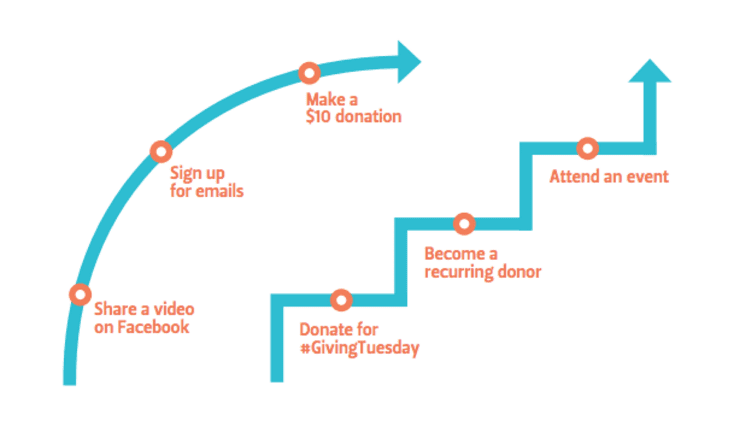Donor retention should be at the forefront of every fundraiser’s mind. Your ultimate goal when raising funds is bringing donors to the table that feel committed to your mission and want to continue donating year after year.
Simply put, your job is easier when you know you can count on a group of loyal donors time after time.
But how do you get donors to remain committed to your organization?
If you are a seasoned fundraiser, you may be familiar with the Harvey McKinnon quote that summarizes donor retention. “Donor loyalty is not about the donor being loyal to you, it is you being loyal to the donor.”
“Donor loyalty is not about the donor being loyal to you, it is you being loyal to the donor.” tweet this
Yes, there are many factors involved with donor retention, but it all boils down to how you are making the donor feel.
Let’s discuss donor retention in detail and consider why donors decide not to give second gifts. By focusing on remedying these problems, you are sure to improve your organization’s retention numbers.
Defining Donor Retention
Donor retention specifically refers to the percentage of an organization’s donors that decide to give a subsequent gift. Nonprofits and other fundraising organizations should keep track of this number as it is a solid indication of successful donor management.
The Fundraising Effectiveness Project, a joint effort between the Urban Institute and the Association of Fundraising Professionals, found that the average donor retention rate in 2011 was 41.5%. This means that nonprofits are retaining less than half of their donors.
That’s not good! Here’s why many donors decide not to give another gift.
Why Donor’s Don’t Give Second Gifts
1. They Weren’t Asked
This is a very simple point, but it is worth mentioning at the beginning of this discussion. Do not, under any circumstance, forget to ask your donors for a gift during your next campaign. This is the number one mistake that fundraisers make.
Many donors will not actively seek out a place to give their donations. They wait until they are asked. You are essentially competing with an unlimited number of other groups for that donor’s money, so don’t forget to ask or assume a gift is something without directly requesting it.
“Many donors will not actively seek out a place to give their donations. They wait until they are asked …” tweet this
2. They Weren’t Thanked
Thank yous are a simple way that an organization can show the donor that they not only received the gift but that it was appreciated.
Laws around donation receipts are pretty standard. But it is important to remember that a donation receipt is not, by any stretch of the imagination, a thank you.
3. They Didn’t Feel Special
Donors need to feel as though their gift was not only appreciated, but essential. When organizations fail to recognize how a donor’s gift fits into the bigger picture, such as through an annual report, pamphlet or another update, they are not likely to retain that donor.
4. They Weren’t Engaged
An organization may have done a great job of asking for a donation, thanking the donor, and then informing them of the return on their gift. But, was that donor engaged after the donation was given?
Engagement and retention are directly linked. When donors aren’t involved with your organization on a level past their money, they are less likely to stay with you for the long haul.
Improve Your Retention
But all’s not lost. There are many ways that you can avoid the traps listed above.
By shifting your focus onto retaining your donors after their initial donations, you are setting yourself and your organization up to succeed. Improve your retention rates by focusing on the following:
Download your free donor retention playbook and calculator:
1. Keep The Lines Of Communication Open
Remember to stay in contact with your donor within reason. You may consider shooting out a monthly or quarterly newsletter and update your Facebook status a few times per week. Either way, each correspondence should include a call to action.
Keeping the lines of communication with your donor open will keep you top of mind when it comes time for a campaign or fundraising event.
2. Learn About Your Donor
Stay away from treating your donor like a monetary transaction. Just as they are investing in your work, you must invest in them. Aside from gathering contact information, you may want to acquire personal information such as age, names of family members, employment information, etc.
Then, don’t just sit on that information. Use it! Send out targeted emails or mailings depending on your donor demographics. If you organize in-person events, check the guest list beforehand and jot down a few notes about the donors scheduled to attend.
Make them feel special because, after all, they really are.
3. Share Your Success Stories
Don’t just report your information in an annual report or another statistical document and then throw it under a subheading on your website.
Share that information with your donors! Gather personal stories, impressive statistics, and calculate your donor’s return on investment and then send it out via mail, email, newsletters, Facebook, YouTube, etc.
A little information goes a long way in ensuring the donor feels that their money is going toward something big.
4. Engage Your Donors
We briefly discussed ending each correspondence with a call to action. Now, let’s take that one step further. Use what you have learned about your donors to move them up your donor engagement ladder.
If you haven’t created one of these, be sure to check out this online guide. The premise behind the ladder is fairly straightforward.
All donors start at the bottom level. As they engage with you and your organization, whether through their giving, connecting via social media, subscribing to the newsletter, or even attending events (just to name a few), you can visually see them moving up through your engagement levels.
Here’s a great example:

Engagement equals donations. The more invested your donor is in your organization, the more loyal they will be.
“Engagement equals donations. The more invested your donor is in your organization, the more loyal they will be …” tweet this
5. Make Your Thanks Count
You need to immediately acknowledge receipt of every donation that you receive, regardless of the amount. Include a message that is personal, informative, and conveys sincere appreciation.
Handwritten notes are ideal, but in our fast-paced world you may not feel as though there is time to do this. If you can’t write your note, at the very least be sure you are personalizing a digital thank you to the best of your ability.
Use your donor’s name (never use a generic salutation), follow with an acknowledgment of their donation amount, and then briefly describe how their gift makes a difference in your organization.
Or, switch it up completely by sending a personal video message, picture, or something entirely different. The bottom line- put a face behind the organization.
Nonprofits that can successfully retain a substantial amount of donors year to year are doing something right- they are making sure that the donor remains the number one priority. Keep your donors loyal, and you’ve got smooth seas ahead.
Editor's Picks
Ultimate Guide To Peer-to-Peer Fundraising
Customer Story: Spur Local Raises Over $1M With Their Give Local Campaign
Fundraising Strategies for Nonprofits: Craft the Best Approach for Your Organization
Create a Killer Fundraising Plan - Best Practices, Strategies, & Downloadable Template



